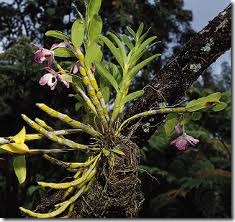Epiphytes are plants that use another for physical support without becoming parasites. Certain species of bromeliads, ferns and orchids grow on the trunk of trees without interfering with their host’s nourishing process. The butterfly and purple shell orchids, as well as those in the Cattleya, Phalaenopsis and Dendrobium species are all epiphytes in their natural habitat. As houseplants, they don’t need a tree, but grow in soil formulated specially for orchids. Different species have particular needs and some shared requirements.
Difficulty: Moderately Easy
Instructions
Things You’ll Need:
- Humidifier
- Fan
- Orchid fertilizer
-
Provide bright indirect sunlight. If the orchid’s leaves turn dark green, increase the intensity of the light. Phalaenopsis — moth orchids — need 1500 to 1700 foot candles, or about 25 watts, for example. Cattleya and Dendrobium orchids require light twice as intense. Fluorescent tubes placed 6 to 12 inches above the plants for 12 to 16 hours a day provide adequate lighting when the sun isn’t available.
-
Place your orchid in a room where you can control the temperature. Cattleya and Phalaenopsis species thrive in night temperatures around 60 degrees Fahrenheit, for example. Dendrobium is a little hardier, adapting to temperatures as low as 52 degrees Fahrenheit. In the day, increase the temperature by 10 to 15 degrees.
-
Water epiphyte orchids weekly, allowing some of the soil to dry between irrigation sessions. Most of these orchids have a built-in system to store moisture. You can easily over-water them if you are not careful. Vanda and Phalaenopsis species are exceptions, lacking the organ that conserves water. Irrigate them as soon as the soil surface dries, which might be daily. Stop adding water to these houseplants when excess begins to run out of the drainage holes. Avoid softened water, which has a high salt content.
-
Run a humidifier in the same room as the orchid, unless you live in a high-humidity area such as the Pacific Northwest or the southern United States. Epiphyte plants get some of the water they need from the moist air. Open a window or run a fan on low to maintain good air circulation, preventing diseases that develop in humid conditions.
-
Fertilize your epiphyte orchid according to the needs of the species. In general, feed it an orchid formula once a month when the plant is actively growing, either producing new shoots or flowers. When all growth stops, suspend fertilization to let the orchid rest.


Deprecated: strpos(): Passing null to parameter #1 ($haystack) of type string is deprecated in /home/agriviek8Qv/agriviet.net/public_html/wp-includes/comment-template.php on line 2522